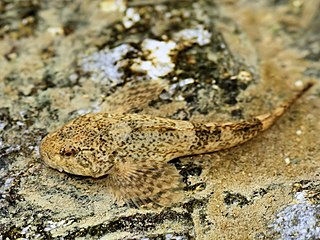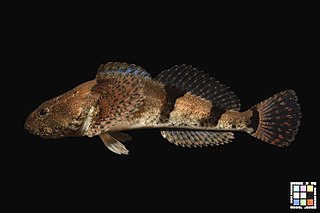
Cottus is a genus of the mainly freshwater ray-finned fishes belonging to the family Cottidae, the typical sculpins. They are often referred to as the "freshwater sculpins", as they are the principal genus of sculpins to be found in fresh water. They are native to the Palearctic and Nearctic.
The Shoshone sculpin is a species of freshwater ray-finned fish belonging to the family Cottidae, the typical sculpins. It is It is endemic to the United States. It inhabits spring systems in the Thousand Springs formation near Hagerman, south-central Idaho. It reaches a maximum length of 9.0 cm. The specific name honors Charles Wilson Greene who was an instructor in physiology at Stanford University and was on the expedition on which the type was collected from the Thousand Springs on the Snake River, near mouth of Salmon Falls River in Gooding County, Idaho.
Cottus scaturigo, the Timavo sculpin, is a species of freshwater ray-finned fish belonging to the family Cottidae, the typical sculpins. It is endemic to the Timavo Spring in Italy. This species was described as a separate species from the European bullhead in 2005 by Jörg Freyhof, Maurice Kottelat and Arne W. Nolte. However, the Catalog of Fishes treats this taxon as a synonym of Cottus metae, although FishBase treats it as a separate species. The specific name scaturigo means "spouting water", i.e. a spring, an allusion to the Timavo Spring.
The Andriyashev largeheaded sculpin is a species of marine ray-finned fish belonging to the family Cottidae, the typical sculpins. This species is found in the northwestern Pacific Ocean. This monospecific genus, and therefore this species, are known from a single specimen, the holotype. This was collected from off Simushir Island in the Kuril Islands at a depth of 100 metres (330 ft). That specimen had a total length of 23.6 cm (9.3 in) long. FishBase classifies this taxon within the Cottidae but other authorities classify it within the subfamily Psychrolutinae of the family Psychrolutidae. The genus name Andriashevicottus includes a patronym, the person honoured was not identified by the describer Fedorov, however, it is almost certainly the Soviet ichthyologist Anatoly Petrovich Andriashev, the patronym is suffixed with Cottus, the type genus of the family Cottidae. The specific name megacephalus means "big head".

Enophrys is a genus of marine ray-finned fishes belonging to the family Cottidae, the typical sculpins. These fishes are found in the northern and eastern Pacific Ocean.

Gymnocanthus is a genus of marine ray-finned fishes belonging to the family Cottidae, the typical sculpins. These fishes are found in the northern Pacific, Arctic and northern Atlantic Oceans.

Megalocottus is a small genus of marine ray-finned fishes belonging to the family Cottidae, the typical sculpins. These fishes are found in the western Pacific Ocean.
The black sculpin is a species of freshawater ray-finned fish belonging to the family Cottidae, the typical sculpins. It is endemic to the United States. Its range includes the extreme upper Clinch and Holston River systems in western Virginia and just into northeastern Tennessee. It reaches a maximum length of 8 cm (3.1 in).
The Sakhalin sculpin is a species of amphidromous ray-finned fish belonging to the family Cottidae, the typical sculpins. It is found in eastern Russia to northern Japan. It reaches a maximum length of 20.8 cm. The Sakhalin sculpin was first formally described in 1904 by the Russian zoologist Peter Yulievich Schmidt with its type locality given as the Lyutoga River on Sakhalin. This species is sometimes placed in the subgenus Cephalocottus. The specific name is a misspelling of Ambystoma, the axolotl combined with opsis, meaning "having the look of", and Schmidt described it as having a head that is "strongly dorsoventrally depressed, wide, nearly flat dorsally, abruptly sloping laterally, similar to the head of an axolotl" (translation).

Cottus duranii, the Dordogne sculpin or chabot d'Auvergne, is a species of freshwater ray-finned fish belonging to the family Cottidae, the typical sculpins. It is found in France. It inhabits the Loire and Dordogne river drainages. It reaches a maximum length of 10.0 cm. It prefers streams with clear, cool, moderate to swift water and stone substrate. This species was described as a separate species from the European bullhead in 2005 by Jörg Freyhof, Maurice Kottelat and Arne W. Nolte. The specific name durani means "of Duranius", the Latin name of the River Dordogne.
Cottus dzungaricus is a species of freshwater ray-finned fish belonging to the family Cottidae, the typical sculpins. It is endemic to China. It reaches a maximum length of 10.0 cm. This species was first formally described in 2006 by the Belgian ichthyologist Maurice Kottelat a replacement name for Li & Ho's Cottus sibiricus altaicus of 1966, a name preoccupied by Cottus poecilopus altaicus which had been named by Nicholas Feofanovich Kaschenko in 1899. The type locality is Altai, northern Sinkiang in China. This species is distinguished from Cottus sibiricus by having a naked body whereas C. sibiricus is covered in prickles. The specific name dzungarius, means belonging to Dzungaria, northern Xinjiang where the species is found.

Cottus rhenanus is a species of freshwater ray-finned fish belonging to the family Cottidae, the typical sculpins. It is found in France, Belgium, Germany, Luxembourg, and the Netherlands. It inhabits the Rhine and Meuse river drainages. It reaches a maximum length of 10.0 cm. It prefers streams with clear, cool, moderate to swift water and stone substrate. Here, it mostly occurs in the shallow parts of streams. This species was described as a separate species from the European bullhead in 2005 by Jörg Freyhof, Maurice Kottelat and Arne W. Nolte. The specific name rhenatus means belonging to Rhenus, the Latin name of the River Rhine.
The Columbia sculpin is a species of fish in the family Cottidae. It is found in the United States and Canada, inhabiting the Columbia River drainage and Harney Basin in Oregon, British Columbia, Idaho, Washington, and Nevada. It reaches a maximum length of 11.2 cm. It prefers rocky riffles of headwaters and creeks.
The Ozark sculpin is a species of ray-finned fish belonging to the family Cottidae, the typical sculpins. It is endemic to Missouri, United States. Inhabiting the Osage, Gasconade, and Black river drainages in Missouri. It reaches a maximum length of 14.0 cm. It prefers rocky riffles of headwaters and creeks.

The fourspine sculpin is a species of freshwater ray-finned fish belonging to the family Cottidae, the typical sculpins. It is endemic to Japan. It reaches a maximum length of 30.0 cm (11.8 in).

Cottus nozawae is a species of freshwater ray-finned fish belonging to the family Cottidae, the typical sculpins. It is found in southern Sakhalin Island in Russia, Hokkaido and northern Honshu in Japan and in the Korean Peninsula. It reaches a maximum length of 6.9 cm. This species was first formally described in 1911 by the American ichthyologist John Otterbein Snyder with its type locality given as the Ishikari River at Sapporo on Hokkaido. This species is sometimes placed in the subgenus Cephalocottus. The specific name honours zoologist Shunjiro Nozawa, Director of the Fisheries Bureau on Hokkaido.
Cottus szanaga is a species of freshwater ray-finned fish belonging to the family Cottidae, the typical sculpins. It is found in Mongolia and Russia. It reaches a maximum length of 8.2 cm. This species was first formally described in 1869 by the Polish naturalist Benedykt Dybowski with its type locality given as the Onon River in the Amur River drainage basin of Russia. The specific name szanaga is derived from Szanaga-sagasu, meaning "spoon fish" the Buryat dialect word for this fish n the Amur basin.
Cottus transsilvaniae is a species of freshwater ray-finned fish belonging to the family Cottidae, the typical sculpins. It is endemic to Romania in the upper Arges River in the Danube drainage. It reaches a maximum length of 9.7 cm. It prefers rocky shoals and riffles of small upland streams. his species was described as a separate species from the European bullhead in 2005 by Jörg Freyhof, Maurice Kottelat and Arne W. Nolte. The specific name transsilvaniae means "of Transsilvania", the Latin name of the Transylvania.
Cottus volki is a species of freshwater ray-finned fish belonging to the family Cottidae, the typical sculpins. This species is endemic to Russia where it is found along the continental coasts of the Sea of Japan but not on the coasts of Peter the Great Bay. It reaches a maximum length of 13 cm (5.1 in). It was previously considered a subspecies of the alpine bullhead. and this species was first formally described in 1933 by the Russian ichthyologist Anatoly Yakovlevich Taranetz as Cottus poecilopus volki with its type locality given as the Suchan River to Takema River on western coast of the Sea of Japan in Primorye. Taranetz did not identify the person honoured in the specific name but it is thought most likely to be his friend Alexander Maksimovich Volk, like Taranetz, Volk was killed in action during World War 2.

Cottus cyclophthalmus is a species of freshwater ray-finned fish belonging to the family Cottidae, the typical sculpins. This species is found in northeastern Europe, in the Neman River and Venta River drainages in the basin of the Baltic Sea. This species is similar to the European bullhead but is distinguished by uts round, protruding and tubular eyes set close to the front of head; papillae in the skin on the top and sides of the head, a scale-less body without any bony prickles and a complete sensory canal on the flanks which has 32–36 pores. It is classified within the subgenus Cottus and the specific name cyclophthalmus is a compound of cyclos, meaning "round", and ophthalmus, which mean "eye", an allusion to the round, tubular eyes.









